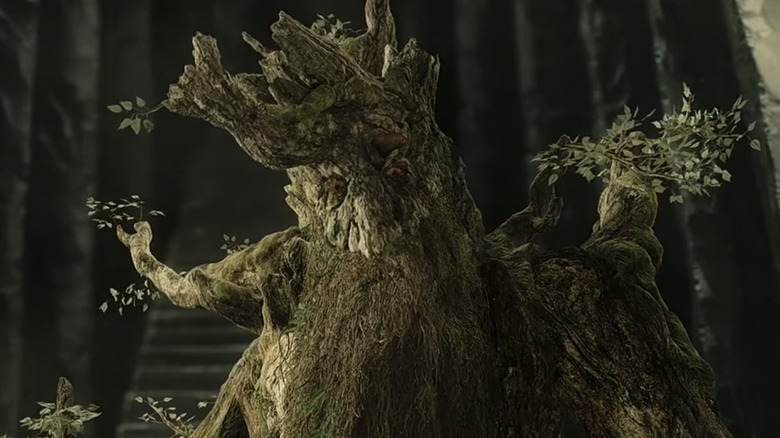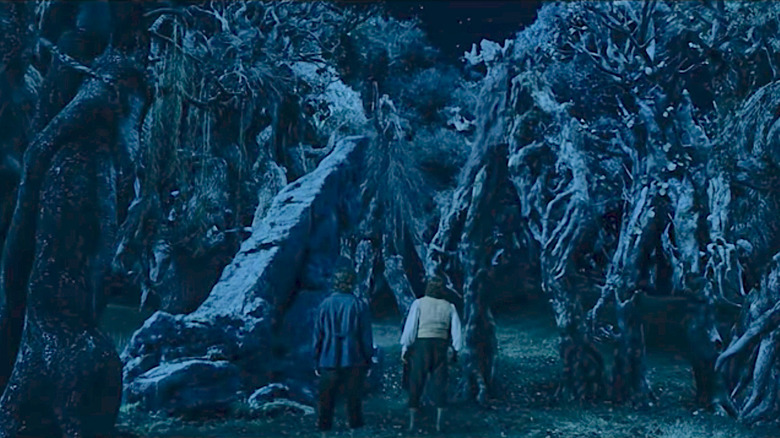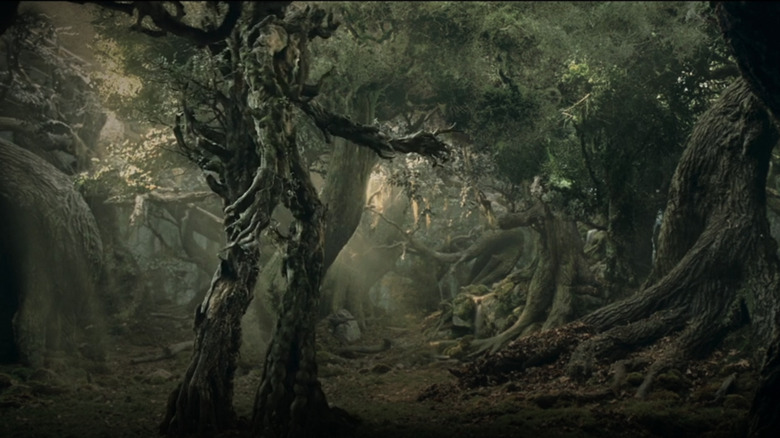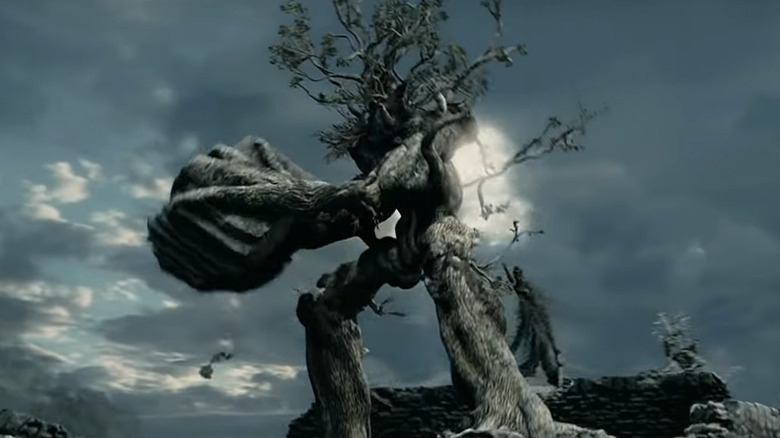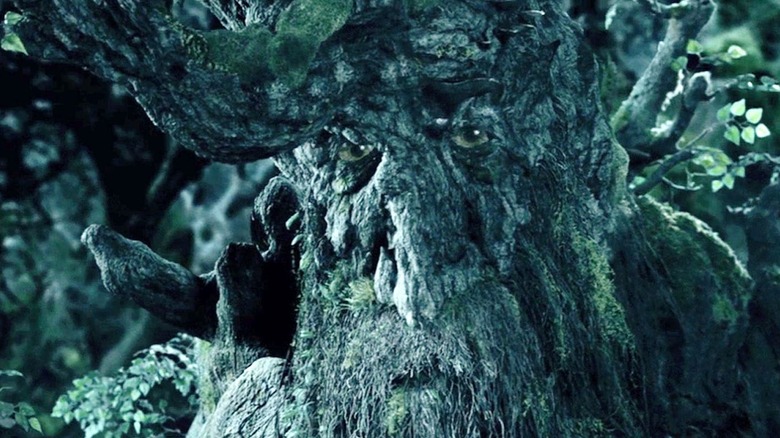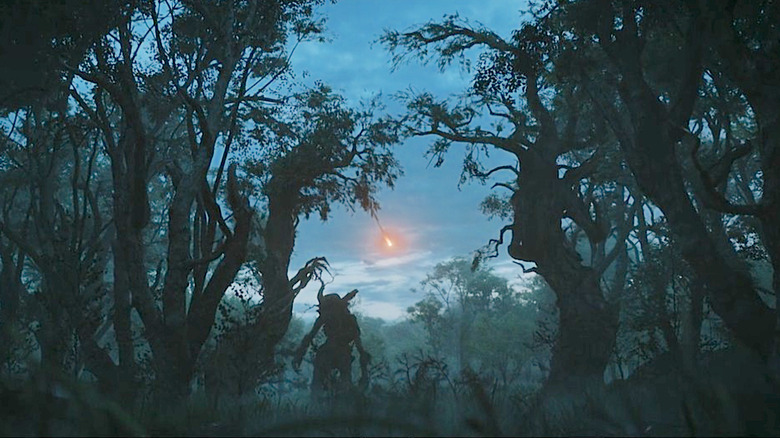Treebeard And The Ents' Greatest Tragedy Fits Right In With The Rings Of Power Timeline
Middle-earth has many staple elements that J.R.R. Tolkien includes throughout his writing. Nods to mythology, war, heroism, fellowships, brotherhoods, and plenty of powerful jewelry show up throughout "The Lord of the Rings," "The Hobbit," and most of the Professor's other writings. Tolkien's world also includes a hefty dose of anti-industrial angst, much of which doubtlessly comes from his own experiences.
Many trace this anti-mechanized bent straight to the trenches of World War I. In the foreword to "The Fellowship of the Ring," Tolkien also personally connects the Scouring of the Shire (infamously left out of Peter Jackson's films) to the experiences of his youth, explaining that "The country in which I lived in childhood was being shabbily destroyed before I was ten."
While the author denies any direct influence that any one event had on Middle-earth, his love of nature — and of trees, in particular — clearly shines through in multiple areas, not the least of which is the Ents of Fangorn Forest. Treebeard and his people are an aggrieved and isolated group of arboreal individuals who, by the time of "The Lord of the Rings," are protecting what little forestry they have left. And when they come together to protect their woods, the results are spectacular. They fight back against Saruman's crafty industrialism with a deep and bitter vengeance.
The part the Ents play in "The Two Towers" is heroic, but it isn't their high watermark. Not by a long shot. In fact, it's more of a last hurrah, a last gasp in a long, mysterious, and painful history filled with mighty deeds, longsuffering, and epic drama. Much of this past centers on a tragic event, too, one that happens to fall precisely during the time that Prime Video's "The Rings of Power" series is set.
A great Entish tragedy
In the book, "The Two Towers," as Treebeard, Merry, and Pippin talk on the way to Isengard to topple the Wizard Saruman, the venerable old tree says that it is "likely enough that we are going to our doom: the last march of the Ents." A bit later, he adds the melancholic thought, "Still, I should have liked to see the songs come true about the Entwives. I should dearly have liked to see Fimbrethil again. But there, my friends, songs like trees bear fruit only in their own time and their own way: and sometimes they are withered untimely."
Treebeard's mention of "Entwives" and "Fimbrethil" and untimely withering refer to one of the saddest and darkest chapters in all of the Ents' very long history: the disappearance of the Entwives. Who are the Entwives? We're glad you asked. Let's start at the beginning, shall we?
Contrary to what a casual viewer might suspect, Ents aren't just trees that can talk. They're created at the beginning of Middle-earth history as living, spirit-filled guardians who are tasked with protecting the flora of Middle-earth. The Ents are, for all intents and purposes, the male half of the race. They live wild lives and tend to watch over the trees and the untamed woods. In contrast, their significant others are the Entwives. They protect smaller growing things, like plants, bushes, crops, and grasses. They are lovers of order, too, and they become world-renowned gardeners. In fact, they are responsible for teaching the many Men in the surrounding regions the art of agriculture, and Treebeard says in "The Two Towers" that "Many men learned the crafts of the Entwives and honoured them greatly; but [the Ents] were only a legend to them, a secret in the heart of the forest."
The Entwives go AWOL
From their earliest days, the Ents and Entwives inhabit various areas of Middle-earth. Initially, they live together and even produce little Entings. Over time, their different interests lead them to the geographic equivalent of sleeping in different beds (Ents in the forest and Entwives in the more open, farmed land), but life is still good, and they continue to see each other regularly.
After the downfall of the first Dark Lord, Morgoth, at the end of the First Age, they reach what appears to have been a golden era. The Entwives' reputation is at its peak, and the Ents regularly visit their orderly cultivated homes in the area that later becomes known as the Brown Lands (for reasons that will become clear in a minute). The area, for easier reference, is located directly below the well-known Tolkienian forest of Mirkwood.
At this time, Treebeard has the hots for an Entwife — or more officially, an Entmaiden — named Fimbrethil, and he and the other Ents drop in every once in a while to see their significant others. This long-distance relationship keeps up until the Númenóreans and Sauron go to war toward the end of the age. What war are we talking about? The War of the Last Alliance. Yep, the same one that ends with Isildur cutting the One Ring from Sauron's hand.
Around that time, Treebeard and the Ents head east to visit the Entwives after a bit of a hiatus. When Treebeard explains this episode to Merry and Pippin in "The Two Towers," he says thusly, "We crossed over the Anduin and came to their land; but we found a desert: it was all burned and uprooted, for war had passed over it. But the Entivewes were not there."
The search of the Ents for the Entwives
It's tempting to assume that the destruction of the Entwives' home marked the end for its inhabitants, too, but, well, that's not entirely true. See, when Treebeard explains the harrowing chapter in his people's history, he adds that "Long we called, and long we searched; and we asked all folk that we met which way the Entwives had gone." He adds that, while some had never seen them, others said they saw them going west, east, and south. So, basically a wild goose chase.
But these vague and conflicting reports keep their hopes alive, as Treebeard emphasizes when he says, "For many years, we used to go out every now and again and look for the Entwives walking far and wide and calling them by their beautiful names." The old Ent adds, "But as time passed we went more seldom and wandered less far. And now the Entwives are only a memory for us, and our beards are long and grey."
Songs are written about this epic rolling search, and the Ents become tragic figures of Middle-earth legend. They don't find the Entwives, either. Three thousand years later, when Treebeard bumps into two Hobbits from the Shire, he's still singing about his long-lost love. But he hasn't given up hope. In fact, he even asks Merry and Pippin if they've seen them up by the Shire, adding that the Ents believe they will meet the Entwives again and live happily ever after together at some future date when they have both lost all that they have. It's a fanciful hope and one that even J.R.R. Tolkien himself wasn't too sure about.
Tolkien's tragic thoughts on the Entwives
In a long letter in 1954, J.R.R. Tolkien responded to a question about the fate of the Entwives. "I think that in fact the Entwives had disappeared for good, being destroyed with their gardens in the War of the Last Alliance (Second Age 3429 – 3441) when Sauron pursued a scorched earth policy and burned their land against the advance of the Allies down the Anduin," he wrote. For those who aren't completely obsessed with Middle-earth geography, Tolkien is referencing the time in the Second Age when a giant army of Men, Elves, and their allies head south from Rivendell to Mordor, passing through the Brown Lands on the way. It's the beginning of the same war depicted (in its final moments) in the opening scene of the movie "The Fellowship of the Ring."
In the letter, Tolkien goes on to give his best guesses as to what may have happened to the poor counterparts of the Entish race during this scorched earth conflict. He suggests that they may have fled to the eastern regions of Middle-earth or may even have been enslaved and forced to work for tyrants. He adds that even if the Ents did eventually find them, they would be estranged by that point due to their very different life experience.
Despite this heartbreaking thought, Tolkien does add a tiny glimmer of hope, very much so in his style, by saying that while the Entwives themselves are gone, they do survive indirectly through the "agriculture" that they transmit to Men and Hobbits. So, when we see those rolling green hills and lush fields in the Shire, we're indirectly seeing a fleeting glimpse of one of the Entwives' greatest gifts to posterity.
Entwife potential in The Rings of Power
All of this begs the question, how can the Entwives end up in "Rings of Power"? The timing part of the question is easy. The Ents and Entwives are at their prime during the first few seasons of the show. This gives the series plenty of room to integrate both halves of Entish culture into its sprawling stories moving forward. In fact, it's something we already got a fleeting glimpse of in the first episode of season 1. When the fireball streaks through the sky, one shot shows what is undeniably a family of Ents — likely an Ent, Entwife, and Enting. There's plenty more potential where that comes from (that is if the creative team is interested in incorporating a world of creatures with that much CGI involved.)
As the five-season story arc approaches its last act, we can presume that the War of the Last Alliance will become its climactic focal point, and when that happens, well, the stage will be set for an absolutely calamitous drama as Halbrand's — er, Sauron's (sorry about that) forces wipe out the farms and either kill, drive off, or enslave the Entwives. Will it happen? We don't know. But it sure does fit in nicely with the larger story web that the show is spinning. Here's hoping the Ents and Entwives find their way into the mix one way or another as we go along.
